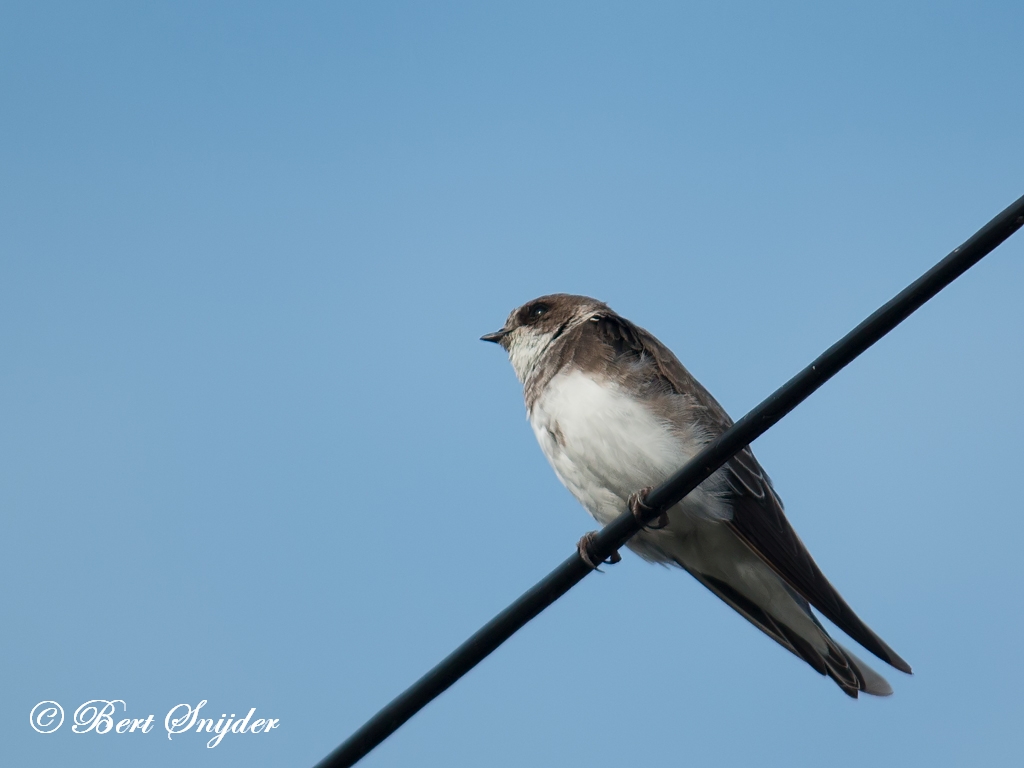Sand Martin, Oeverzwaluw, Uferschwalbe, Andorinha-das-barreiras, Avión Zapador
Spotted in the Alentejo region of Portugal. Sand Martin sound
The Sand Martin (Riparia riparia) is a migratory passerine bird in the swallow family. It has a wide range in summer, embracing practically the whole of Europe and the Mediterranean countries, part of northern Asia and also North America. It winters in eastern and southern Africa, South America and South Asia. It is known as Bank Swallow in North America, and as Collared Sand Martin in South Asia, and sometimes as European Sand Martin.

The 12 cm long Sand Martin is brown above, white below with a narrow brown band on the breast; the bill is black, the legs brown. The young have rufous tips to the coverts and margins to the secondaries.
Its brown back, white throat, small size and quick jerky flight separate it at once from similar swallows, such as the House Martin (Delichon urbicum), the Cliff Swallow (Petrochelidon pyrrhonota) or other species of Riparia. Only the Banded Martin (R. cincta) of sub-Saharan Africa is similar, but the Sand Martin only occurs there in winter.
The Pale Martin is the subspecies diluta of northern India and southeastern China is sometimes split as a separate species Riparia diluta. It has paler grey-brown upperparts and a less distinct breast band. It winters in Pakistan and southern India.
The Sand Martin’s twittering song is continuous when the birds are on the wing, and becomes a conversational undertone after they have settled in the roost. The harsh alarm is heard when a passing falcon, crow or other suspected predator requires combined action to drive it away.
The Sand Martin appears on its breeding grounds as the first of its family, starting towards the end of March, just in advance of the Barn Swallow. In northern Ohio, they arrive in numbers by mid-April in our time, about 10 days earlier than they did 100 years ago. At first, they flit over the larger bodies of water alone, in search of early flies. Later parties accompany other swallow species, but for a time, varying according to weather, the birds remain at these large waters and do not visit their nesting haunts. The Sand Martin departs early, at any rate from its more northerly haunts. In August, the gatherings at the nightly roost increase enormously, though the advent and departure of passage birds causes great irregularity in numbers. They are essentially gone from their breeding range by the end of September.
The food consists of small insects, mostly gnats and other flies whose early stages are aquatic.
The Sand Martin is sociable in its nesting habits; from a dozen to many hundred pairs will nest close together, according to available space. The nests are at the end of tunnels of from a few inches to three or four feet in length, bored in sand or gravel. The actual nest is a litter of straw and feathers in a chamber at the end of the burrow; it soon becomes a hotbed of parasites. Four or five white eggs are laid about mid-late May, and a second brood is usual in all but the most northernly breeding sites.
This is not a rare bird, and it is classified as a species of Least Concern by the IUCN.

Other synonyms:
Afrikaans: Europese Oewerswael
Asturian: Andarina de Ríu
Breton: Ar wennili-vriell
Catalan: Cabot de vorera, Oreneta de ribera, Orenete de ribera, Picot garser petit
Catalan (Balears): Cabot de vorera
Valencian: Picot garser petit
Czech: bøehule øíèní, Brehule rícní
Welsh: Gwennol y glennydd, Gwennol y llynoedd, Gwennol y traeth
Danish: Digesvale
German: Europäische Uferschwalbe, Uferschwalbe
English: Bank Swallow, Collared Sand Martin, Collared Sand Martin/Bank Swallow, Collared Sand-Martin, Common Sand Martin, Common Sand-Martin, European Sand Martin, Gorgeted Sand-Martin, Sand Martin, Sand Swallow
Esperanto: bordhirundo
Spanish: Avion zapador, Avión Zapador, Avíon zapador, Golondrina barranquera, Golondrina de Collar, Golondrina Parda, Golondrina Parda Chica, Golondrina Riberena, Golondrina Ribereña, Golondrina zapadora
Spanish (Argentine): Golondrina zapadora
Spanish (Bolivia): Golondrina zapadora
Spanish (Chile): Golondrina barranquera
Spanish (Colombia): Golondrina Ribereña
Spanish (Costa Rica): Golondrina Riberena, Golondrina ribereña
Spanish (Cuba): Golondrina de Collar
Spanish (Dominican Rep.): Golondrina de Collar
Spanish (Honduras): Golondrina ribereña
Spanish (Mexico): Golondrina Ribereña
Spanish (Nicaragua): Avión Zapador
Spanish (Paraguay): Golondrina zapadora
Spanish (Uruguay): Golondrina Barranquera, Golondrina Parda Chica
Estonian: Kaldapääsuke
Basque: Oreneta de ribera, Uhalde-enara
Finnish: Törmäpääsky
Faroese: Áarsvala
French: Hirondelle de rivage, Hirondelle des sables
Friulian: Pic piçul
Irish: Bruachalán, Gabhlán Gainimh, Gamhlán gainimh
Gaelic: Gobhlan Gainbhich, Gobhlan Gainmhiche
Galician: Andoriña das barreiras, Oreneta de ribera, Peto
Guarani: Mbyju’i
Manx: Gollan Geinnee, Gollan gheinnee
Haitian Creole French: Irondèl kolye senp
Croatian: Bregunica
Hungarian: Parti fecske, Partifecske
Indonesian: Layanglayang Pasir
Icelandic: Bakkasvala
Italian: Topino, Topino comune
Japanese: Shohdo-tsubame, shoudoutsubame, Shoudou-tsubame
Cornish: Gwennol tewas, Kasek koes vrith vyghan
Kwangali: Sisampamema
Latin: Riparia riparia, Riparia riparia riparia
Ladin: Becalen pice
Lithuanian: Kriugždas, Urvine kregžde
Latvian: Alene
Malay: Layang-Layang Awan
Maltese: îawwiefa tax-Xtut
Dutch: Europeese Oeverzwaluw, Oeverzwaluw
Norwegian: Jordsvale, Sandsvale, Strandsvale
Occitan: Pic pichòt
Polish: brzegówka, brzegówka (zwyczajna), brzegówka zwyczajna, Górniczek
Portuguese: andorinha, andorinha das barreiras, Andorinha-das-barreiras, Andorinha-das-barreiras-europeia, Andorinha-de-barranco, Andorinha-do-barranco
Portuguese (Brazil): andorinha, Andorinha-do-barranco
Romansh: Pitgalain pitschen, Randulina da riva
Russian: Beregovushka
Scots: Gobhlan gainbhich, Gobhlan gainmhiche
Northern Sami: Derpmoš
Slovak: Brehul’a hnedá
Slovenian: breguljka
Shona: Nyenganyenga
Albanian: Dallëndyshe e lummit
Serbian: lasta bregunica
Swedish: Backsvala
Swahili: Kinegwa wa Kizungu, Kinegwa-mchanga
Travel Birdwatching Holiday Alentejo, Vacation Portugal for birders to see birds on your trip. Guided Birdwatching Tours & Trips.